|
Click Here to view this email in your browser
NACDEP Fall 2021 Newsletter
Colleagues: Greetings and welcome to the Fall 2021 edition of the NACDEP newsletter. We have some interesting items for you in the current issue, and as you will see, it is not too early to be thinking about Indy in 2022. This is the first time we will be convening together in person since 2019. Note that the opening date for submissions to the conference is approaching very quickly – Nov. 1, 2021, with a deadline of Jan. 19, 2022.
Beyond the information about Indy 2022, we have an eclectic bunch of items in this edition of the newsletter, from community stewardship to community broadband ... well, see for yourself! Enjoy the newsletter.
Thomas W. Blaine, PhD
Newsletter Editor
President's Column
Back Together Again
Submitted by Melinda Grismer, NACDEP President Dear Friends, The NACDEP Board was together again – in person -- from September 15-17, 2021, in Indianapolis to visit with the NACDEP 2022 conference host committee and plan for the future sustainability of our organization. There was a lot of bonding – and a lot of thinking about you, our members, and how we can offer the most value to each other as colleagues and fellow community development professionals.
The transition to a hybrid work style has afforded us all some time to reflect on what works and what doesn’t – what we should continue doing, start doing and stop doing.
By showing up at our Wednesday Webinars (hosted by NACDEP’s Member Services Committee), you are telling us to keep providing opportunities for virtual member engagement throughout the year. So we will! In fact, we are going to provide an option in this year’s call-for-proposals for you to present at one.
By chartering a new standing committee, you are telling us to start doing more DEI (diversity, equity and inclusion). So we will! In fact, a group of 15+ NACDEP members are co-creating the organizational structure of this committee to ensure it is responsive to the needs it was originally intended to address – and flexible enough to incorporate new ones as it evolves and grows.
By endorsing an in-person conference in 2022, you are telling us you want to be together again – in-person – with safety precautions in place so we can enjoy being in the presence of one another, which is something we will not take for granted post-pandemic.
We, as a board, take seriously the charge to represent you as NACDEP members. And, this fall, we also took seriously the opportunity to get to know each other better so we could serve you even better. We held our first in-person, pre-game meeting, and actually played a giant Jenga strategy game!
Myself, and another board member (who shall remain anonymous, see inset photo below), actually toppled the tower for our respective teams. Whoops! I hope we are better at leading NACDEP than playing giant Jenga! The point is, we had fun being together again! And, you will too, as you commit to traveling to Indianapolis this summer, where you will certainly create connections at every crossroad!
 . . 


Community Stewardship - Helping Volunteers Lead and Fund Projects
Submitted by Linda Falcone, Suzanna Windon and Lori Voll-Wallace
PennState Extension
The Goal
The Penn State Extension Leadership and Community Vitality (L&CV) team and the Master Gardener team saw a need to develop more volunteers who take action to address climate change. The team believed two things slowed the initiation of volunteer-led projects: the lack of leadership skills and funding.
To address this, L&CV developed an integrated project to create a research-based leadership program that complemented existing Master Gardener (MG) instruction. The training would empower volunteers to lead and implement local projects. The pilot program was conducted for adult volunteers and funded by a Penn State College of Agriculture Science-to-Practice grant. The team then modified the program to educate youth. The youth pilot program was funded by a grant from the Pennsylvania Department of Environmental Protection.
The Pilot Program
The project began by surveying over 1000 Master Gardeners to identify factors influencing participation in local environmental projects and identify skills needed to become stronger project leaders. The pilot training topics were based on the survey results with instruction lead by L&CV Faculty and Educators. Twenty-six volunteers from four counties enrolled in the pilot. Participants were to attend class, work as part of a county-based team, write a team mini-grant, implement a team project, and develop educational materials related to the project.
The pilot consisted of 15 hours of interactive lecture and 10 hours per person of project implementation time. Lecture topics included leadership styles, team development, working with local leaders, and conflict management. The subject that participants found most beneficial was grant writing, where they learned about measuring impact and preparing a grant proposal. Once county-based teams identified a project, they were then required to write a grant proposal to the L&CV team outlining the project, explaining its impact, and preparing a budget. The L&CV team evaluated and compared the proposals. Then they awarded funds from the pilot grant to each team. Teams also received written critiques of their proposals with suggestions to improve the proposal and the projects.
Impact
As a result of the training, four projects were developed and implemented by the county-based teams. One county team cleaned an overgrown garden at a state park and planted pollinators to rejuvenate the garden. Another team created a rain garden around a pavilion at a new municipal riverfront park. A third team conducted soil health testing experiments and offered training that included soil test kits for participants. The fourth team partnered with a community volunteer group to educate residents about native plants and distribute plants to low-income homeowners. Teams also developed educational presentations and materials, gathered letters of recognition from the community and created impact statements to use for education and publicity in the future. The four projects that resulted from the pilot were very different, and each offered unique educational benefits.
As a result of the project, over half of the people surveyed said they are more likely to lead a community project in the future, and 86 percent said it improved their leadership skills. One participant wrote, “I really enjoyed the content on leadership and have learned things I was able to apply to both this project and my career. I am grateful for the opportunity to gain real-world experience in leading a community project and appreciate how much effort, hard work, and determination goes into the entire process.” Based on feedback from participants, final alterations will be made to the program, and the team will continue to seek grant opportunities to run this program statewide.
Mt. Pisgah Project, October 2020 Photo by Kathy Odewnweller
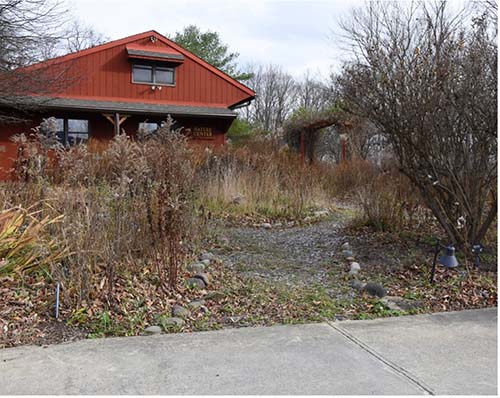
Mt. Pisgah Project, August 2021 Photo by McKayla Accettulla
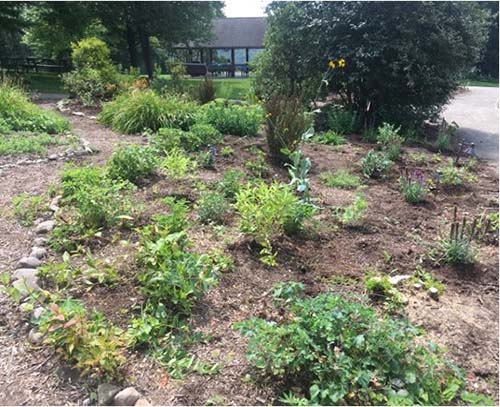
Advancing Community Broadband
Submitted by Keith Taylor
I will be organizing a webinar and informational series on advancing community broadband. While I am in the UC California system, this is intended to scale to a national audience.
I am looking to
- Evaluate educational needs for bridging the broadband divide.
- Broadband 101 (fiber, 5g, and everything in between)
- Model for broadband deployment (co-op, muni, independent, investor owned)
- Model policy for advancing broadband
- How we did it: Success stories from the field
- Disseminate through Extension to policymakers, community leaders, and values-aligned utility professionals
Partner on webinars with Extension leaders, where relevant.
I’d like for interested parties to reach out to me. Seeking folks to:
- Co-create content
- Team on key educational-extension initiatives
- Advertise the series to interested stakeholders.
My contact information is [email protected]
 We'll See You in Indy at the 2022 NACDEP Conference We'll See You in Indy at the 2022 NACDEP Conference
Submitted by Kristi Whitacre, Purdue University Extension, Publicity Chair
Save the dates of June 5-9, 2022, and join us for the in-person NACDEP conference, the premiere professional development and networking opportunity of the year! The conference will be held in downtown Indianapolis, Indiana, at a fun art-based hotel with so many beautiful displays and fascinating stories right on site, as well as so many awesome options for workshops. Check out their website here https://www.thealexander.com/.
Check out this video about Indy…
The complete schedule will be released soon. Here’s a quick preview:
- Networking! It’s been too long since we’ve all been together. Come connect with fellow community development professionals in the sessions, social, and hospitality events!
- Call for Proposals for conference workshops, presentations and posters will open on Nov. 1, 2021. Jan. 19, 2022, will be a firm deadline to submit any proposals, so block off some time in November or December to get started! Limited opportunities to present virtually later on in the year will be available for those who cannot participate in the conference because of travel restrictions. Our NACDEP members look forward to learning about your great community development work and ideas.
- So many great mobile workshop options!
Watch for updates in the coming months!
The Online Journal for Rural Research and Policy (OJRRP) Special Issue
Submitted by Rebecca Dudensing
Texas A&M
The Online Journal for Rural Research and Policy (OJRRP) seeks papers for a special issue to examine the impact of COVID-19 on rural communities and landscapes. Research topics may include, but are not limited to public health, education, mental health, economic impact, and discourse narratives about the pandemic. Prior research has demonstrated that rural communities in the US often have fewer medical, social, and educational resources when compared to urban hubs (Hartley, 2004; Bard, Gardener, & Wieland 2006). Catastrophic events can exacerbate such inequalities leading to increased mortality rates and straining already overburdened educational and social systems. For example, lack of broadband in rural communities raises challenges to students who may not be able to attend in-person schools and puts pressure on school systems to maintain in-person classes, while also exacerbating isolation as online communication rapidly grows in the face of travel restrictions. At the same time, rural communities remain key components of essential agricultural supply chains, feeding the nation despite new challenges introduced by pandemic conditions. We seek research that documents the impact of COVID-19 on rural communities, provides historical context, or identifies strategies to improve resiliency and sustainability among rural communities.
Requirements for Submission
The Online Journal for Rural Research and Policy is a peer-reviewed, online publication. It publishes academic and community-based research, commentary, and policy articles focused on rural places and spaces. We encourage the submission of works from a broad range of fields examining the Great Plains in a way that is of interest to both academic and community audiences. The goal is not only to present theory, but to stimulate discussion, encourage more research on rural issues, and improve access to information that promotes decision-making that enhances rural people and places. Word limit: 5,000-10,000 words, but longer papers are considered; tables and references do not count towards word limit. Supplementary materials may be added as a separate document, do not count towards word limit, and have no word limits. We do not have formatting requirements on initial submission; any consistent academic style (APA, MLA, Chicago, etc.) will be considered. For information on whether your work fits with the mission of the Journal please contact either Dr. Tuan Nguyen at [email protected] or Dr. Mary Kohn at [email protected].
References Bard, J., Gardener, C., & Wieland, R. (2006). National Rural Education Association report rural school consolidation: History, research summary, conclusions, and recommendations. The Rural Educator, 27(2), 40-48 Hartley, D. (2004). Rural Health Disparities, Population Health, and Rural Culture. American Journal of Public Health, 94 (10), 1675–1678
The website is https://newprairiepress.org/ojrrp/
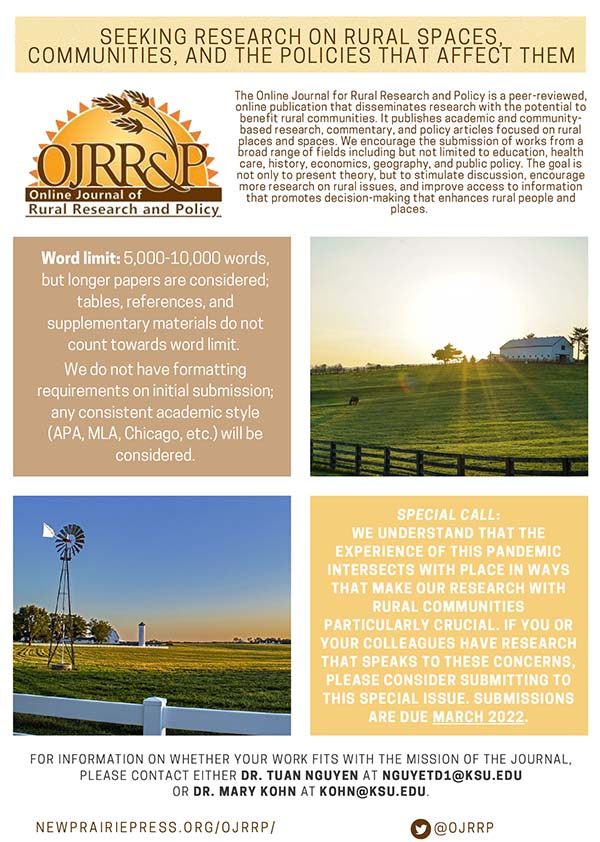
Virtual Housing Forum
Submitted by Melissa Hamilton
University of Idaho Extension
Join the NACDEP Land Use Planning Community of Practice (CoP) to learn about Extension's contributions to address the national housing issue. The webinar will be on December 15, 12:00-1:30 pm ET. Learn from a panel of Extension guest speakers about implemented programs and impacts. Participants will be engaged in breakouts to discuss the complexities of housing in their community -- and how it relates to their Extension programs and work. Register today: https://tinyurl.com/2ys5py2k
Call to Action: National Extension Housing Programs Survey
Please take a few minutes to complete this five-question survey from the Land Use Planning CoP – a NACDEP Working Group. The information collected will give the committee an understanding of all national Extension program efforts (past and present) related to this topic. The results of this survey will be shared at the December 15 webinar. Thank you in advance for your time and participation.
https://uidaho.co1.qualtrics.com/jfe/form/SV_8cEBoOd45jMOJW6
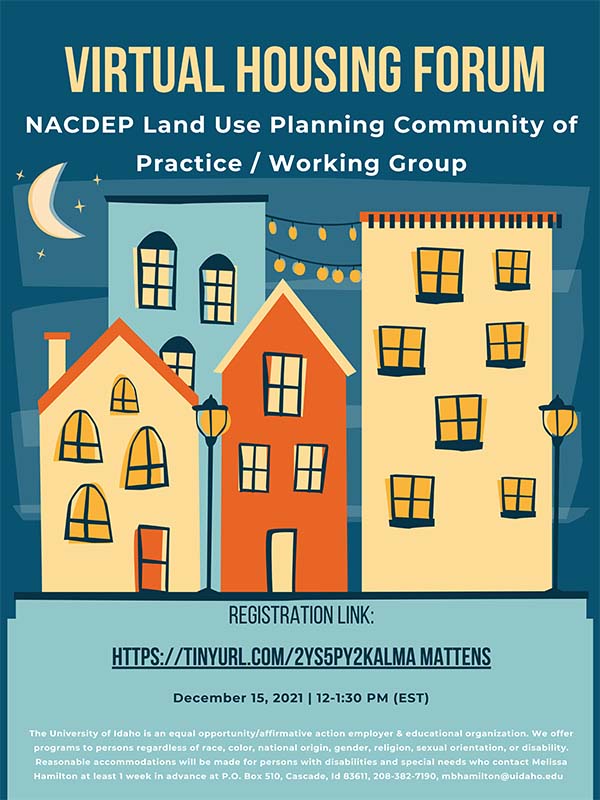
Wednesday Webinar Series
Submitted by Michael Dougherty, NACDEP Member Services Committee Chair, [email protected]
The NACDEP Member Services committee is bringing back its Wednesday Webinar series for another year.
The November webinar will be “Using the Pivot Grant Database” presented by Jan Steen, a Community Vitality Specialist with K-State Research and Extension and the Kansas Pride Program. It will be held on Wednesday, Nov. 10, 2021, at 3 p.m. ET. A reminder – with the Zoom link for the webinar – will be sent closer to the event date.
The December webinar will focus on mental health and mental well-being. The committee felt this was an important and useful topic – especially considering that Extension is a fixture in many places and often serves as a coordinator and connector in times of crisis (while other entities sometimes suspend operations). The committee is still seeking an individual or team to make this presentation and welcomes suggestions. The session is tentatively scheduled for Dec. 8, 2022, and more information will be made available later.
More information about the webinars being planned for 2022 will be announced later.
Ohio's Noble County Celebrates Kick-Off of East I77 Water Expansion Project
Submitted by Gwynn Stewart, MS
Ohio State University Extension
Nestled in the foothills of the Appalachians is Noble County in Southeast Ohio. The Noble Board of Commissioners with the Noble County Water Authority (NCWA) recently hosted a kick-off event for the East of I-77 Water Expansion project. The new service will expand water to 126 homes from Sarahsville to Pleasant City as well as provide an emergency interconnect to the neighboring Village of Byesville Water system in Guernsey County.
“The Noble County Water Authority is pleased to be expanding services to Noble residents,” said Bob Bond, President of the Authority Board. “We are pleased to have $1,943,636 in grant funding through the Ohio EPA and H20 Ohio and $322,000 from the Appalachian Regional Commission to support the project as well as a $2,495,391 zero-interest rate 40-year loan from Ohio EPA to expand our local water infrastructure.”
“This project has been years in the planning but we are excited that construction will commence in early October,” said Commissioner Brad Peoples, President of The Noble County Board of Commissioners.
Peoples added that there were many partners in planning and helping secure funding for the project including the Ohio EPA’s Division of Environmental and Financial Assistance, The Ohio Governor’s Office of Appalachia and the Appalachian Regional Commission (ARC), the Noble County Emergency Management Agency, Ohio State University Extension – Noble County Community Development, Ohio RCAP and Buckeye Hills Regional Council.
That was the project press release recap, below is the project work recap.
The origination of the project was a meeting on a Monday in the Noble County courthouse with Commissioners. The Extension CD Educator was there for another purpose and an engineer was discussing the project’s potential costs. This leads the Commissioners to turn to Extension for suggestions and the Educator suggests coordinating a cross-functional team to tackle the project.
For Extension Community Development, which operates from a strategic plan prioritizing expansion of water and broadband infrastructure as key county priorities, the project was an exercise in collaboration and partnership. Our purpose was to keep the project team meeting, working together, jumping hurdles, encouraging, applying for funding and getting to the big checks.
Extension invited key partners including representation from the local Water Authority and its engineering firm, Commissioners, the Regional Development District (partners for public works, CDBG and Appalachian Regional Commission funding), Ohio RCAP (partners to Ohio EPA funding), and others as needed to collaborate on the project. In the early months, we met in person. But then, Community Development Extension used project management and Zoom tools to keep folks meeting in the midst of a global pandemic and to keep sub-projects on task and on time.
The lessons learned were many.
You win some, you lose some. Sometimes you apply for grants and don’t win. Swallow your pride, learn something from the process and keep moving forward. Early on, the project didn’t qualify for Community Development Block Grant (CDBG) funding. The long and arduous process of determining with house-by-house income surveys that the project area was not qualified based on low-to-moderate income need meant it was a “no” on the grant option of $750,000. The effort also didn’t qualify for Ohio Public Works grant/loan funding based on a very competitive round and scoring that weights roads and bridges and fixes higher than new builds – there were 49 projects totaling over $21 million in requests with only 23 grants funded at just over $9.9M. The project was also too much of an unchartered territory for the Emergency Management Administration BRIC grant program and funding from the US Army Corps of Engineers while offered a chance, was determined to be too much of a time delay for the project team’s comfort.
 Patience is a virtue is another important lesson learned. Extension was responsible for writing the grant application to The Appalachian Regional Commission process. In Ohio, there is a basic pre-application process (due in March) and then you wait, and wait, and wait for word that the project will receive a chance. The regional selection process included a record number of 185 applications for only 15 projects to move forward to a full application. Patience is a virtue is another important lesson learned. Extension was responsible for writing the grant application to The Appalachian Regional Commission process. In Ohio, there is a basic pre-application process (due in March) and then you wait, and wait, and wait for word that the project will receive a chance. The regional selection process included a record number of 185 applications for only 15 projects to move forward to a full application.
The relationships built with funding partners over time netted some additional funding options when project bids came in higher than expected due to pandemic issues related to project supply availability when an ARC grant was later increased from $250,000 to $322,000 with some excess funding available for “ready” projects. We would remind ourselves that every grant dollar helps carve the end-user’s monthly water bill down and keep the project moving toward reality.
Project Notebooks and grant applications (won and lost)
Multiple layers of government funding paperwork is no joke. The team’s connection to Ohio EPA funding was through the experts at Ohio Rural Community Assistance Program (RCAP). They know the ins and outs of “nominating” projects for funding through the EPA Drinking Water Assistance Fund (DWAF) loan and grant process and assisted greatly. When word that the project funding was announced came, on page four of the 10-page spreadsheet, the Noble project was found earning a 40-year, zero percent interest loan for $2,495,391, for a large portion of the project. The process was long and laborious and happened not just once, but twice due to the long planning timeline of the project making a re-nomination required.
On the bright side, as the project was discussed with funding partners, staff at the Ohio EPA felt confident it was a “good fit” for nomination to a federal EPA funding stream known as WIIN (Water Infrastructure Improvements for the Nation Act) and they assisted with the hurdles of the Ohio application for the federal funding by also including grant support for the “match” from Ohio H20 funding, all tolled bringing the project $1,943,636 in grants – a true “WIN.”
Never underestimate the power of small-town people. Team members know everyone on the waterline path and the best connected would help with securing project easements and with negotiating terms for placement of key project equipment like water tanks. There were also the faith-based partners who stepped up offering to defer some of the costs of tap fees for the low-income households on the route. Human kindness at its best.
Even in 2021, the pathway to public water is a rocky one. It is cobbled with public meetings, resolutions, letters of support, grant applications, engineering studies, phase I environmental studies, mapping, property easements, water board meetings and minutes, legal reviews, public bids, bid openings, tap fees, locating and surveying water tank sites, prevailing wage verifications, negotiating, coalition building and partnerships, starts and stops, losses and wins, pre-construction meetings (where word comes that what was once 90 homes is now up to 126 who want to sign on for public water) and then the big-check kick-off events.
Plan your work and work your plan. One success now serves as the spark for next-step planning for add-on routes to reach even more homes through once-in-a-lifetime funding flowing from both local, state and federal resources for water and sewer infrastructure.
In the end, for a community development professional, it is said best in the quote from WVHub, “Community Development is the act of making a place the best version of itself.”

Noble County Commissioners and Water Authority (NCWA) hosted an East of I-77 water extension kick-off for project partners and funding agencies last week. From left front row: Ohio EPA Assistant Chief Office of Financial Assistance, Jonathan Bernstein; Ohio EPA Director Laurie Stevenson; Noble Co. Commissioner Gary Saling, NCWA President Bob Bond, Noble Co. Commissioner Brad Peoples, Amber Kohler, SE Representative for Congressman Bill Johnson; and Ohio State University Extension CD Educator, Gwynn Stewart. Back row from left: Jeff Vaughn of Vaughn, Coast & Vaughn Engineering; Mike Muncie, TAM Construction; Casey Karn, Mid-Atlantic Storage Systems; Noble EMA Director & Project Manager Chasity Schmelzenbach, Byesville Mayor Jay Jackson; Ohio Senator Frank Hoagland; Noble Co. Commissioner Ty Moore; and Director of the Ohio Governor’s Office of Appalachia, John Carey.
Photo by James Lee, Ohio EPA.

Rural Development Research and Outreach Professionals Invited to Participate in National Survey on Rural Community, Economic, and Workforce Development Priorities
Submitted by Michael Wilcox
Purdue Extension
The four Regional Rural Development Centers invite rural-focused leadership and professionals working on issues of community, economic, and workforce development to participate in a national survey. The survey is the first phase of a listening sessions process aimed at identifying key priorities and critical investments for rural communities' recovery and growth. The RRDCs ask that rural development research and Extension/outreach leaders (1) complete the survey below and also (2) share the survey with those in their networks engaged in community and economic development activities. We ask that all surveys be completed and submitted ASAP (since the original deadline was October 6). Timely completion will ensure that responses inform a preliminary report that will be shared by the RRDCs with USDA NIFA and other federal partners as stakeholder feedback.
To access the survey and submit responses, visit: https://bit.ly/RuralPrioritiesSurvey
If you have questions, contact Michael Wilcox at [email protected]. The attached invitation letter also has additional details. Please feel free to share with your colleagues and Extension Leadership team members.
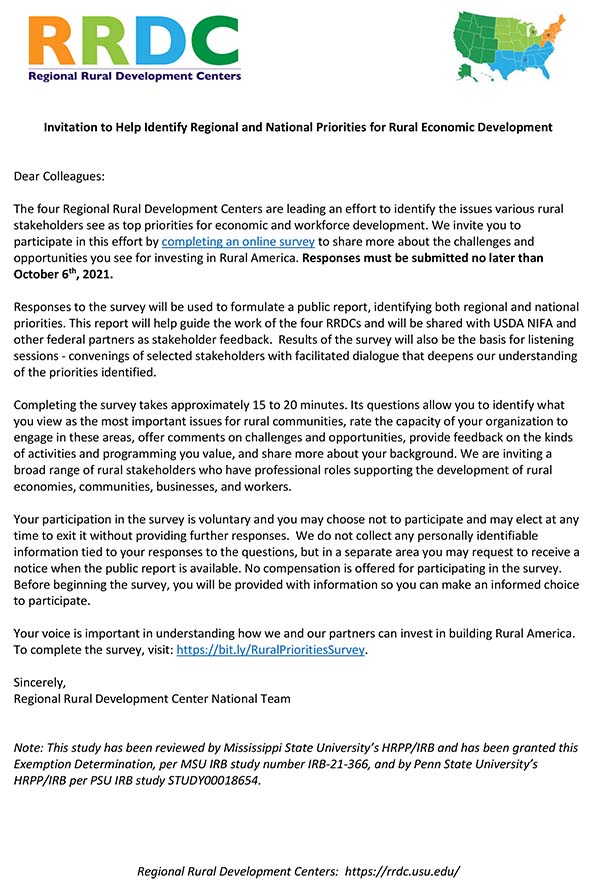
NACDEP 2021 Award Winners
Submitted by Tamara Ogle
Purdue Extension
Join us in congratulating our 2021 NACDEP Award Winners! We will feature a few of our national winners in each newsletter. This is another opportunity to share some of the great community development work of our NACDEP members.
This could be you next year! Start thinking about the great programs you and your colleagues have created that deserve to be recognized and shared. The awards portal will open in early December and close February 28.
2021 NACDEP Innovation and Creativity Team Award Winner
Ryan Sandwick & Cameron Correll, University of Kentucky CEDIK
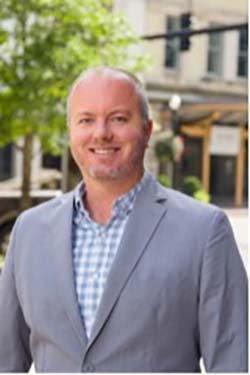 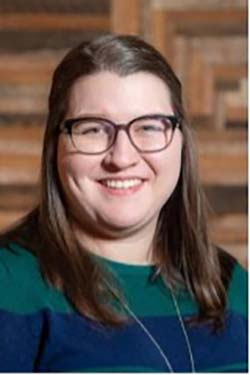
The Sidewalk Subway is a placemaking project that welcomes people to explore the unique character of downtown Cynthiana. Working with a broad consortium of local partners, the project is a series of themed walking tours that are inspired by subway and metro maps from cities across the world.
Seeking to safely encourage people back downtown to celebrate the elements that make downtown Cynthiana unique during the COVID-19 pandemic, this project was funded by a cost-share grant by the Community and Economic Development Initiative of Kentucky (CEDIK). Working in conjunction with the Harrison County Community Fund, in addition to local partners including the City of Cynthiana and the Cynthiana Main St. Program, this project supports an interactive downtown that will enhance the customer experience.
Using Cynthiana’s downtown pocket park on Main St. as the ‘central station’, from there four walking tours spread out: Downtown Attractions, Historic Churches, Murals, and the Main Street Mile. A vinyl map has been attached to the pocket park’s fence, showing the routes and providing additional information. Each route has a designated color, with associated color-coded circles spray-painted along each tour path. In front of each destination is a ‘stop’, allowing people to follow the walking tour they are specifically interested in. This project was installed for less than $500 and with a dozen local volunteers. The goal of this project is to enhance the walkability of downtown and encourage more people to safely explore and experience downtown’s unique character.
How-to-Guide link HERE
See Photos of the Sidewalk Subway in Cynthiana, KY
2021 NACDEP Cross Program Team Award Winner
Food for a Long Life: Partnering to Improve Community Food Access
Crystal Tyler-Mackey, VCE/ Virginia Tech, [email protected]
Shannon Jarrott, The Ohio State University
Karen Tanner, VCE/ Virginia Tech
Jill Narr, Appalachian State University
Jenny Lobb, The Ohio State University

Food for a Long Life utilized intergenerational strategies and the community-based participatory action research (CBPAR) approach to address food security in partnered preschool and adult day service sites in communities that have been identified as food insecure in both Columbus, Ohio, and Lynchburg, Virginia. The long-term aim of the project was to promote sustainable services to address community needs related to healthy food access, consumption, and education through intergenerational relationships embedded within interventions that allowed youth and older adults to create synergy and showcase their abilities and talents. Desired long-term results included fostering strong partnerships among community sites and Cooperative Extension to better provide services for the partnered sites, integrating intergenerational strategies within community sites to address food security and nutrition, and to understand new intergenerational approaches that prove beneficial to program success.
Despite programming pivots due to COVID-19 safety protocols, FFLL continued efforts toward promoting sustainable services at the partnered sites. Regarding nutrition education, FFLL supported 11 educators and Cooperative Extension professionals in obtaining the SNAP-Ed approved training for the preschool nutrition curriculum Together, We Inspire Smart Eating (WISE). Most noteworthy is the potential impact of FFLL’s pilot efforts implementing the WISE curriculum in Virginia and contributing to WISE possibly becoming the primary preschool nutrition curriculum to be used across the state of Virginia, furthering sustainability of a successful model.
The End
|